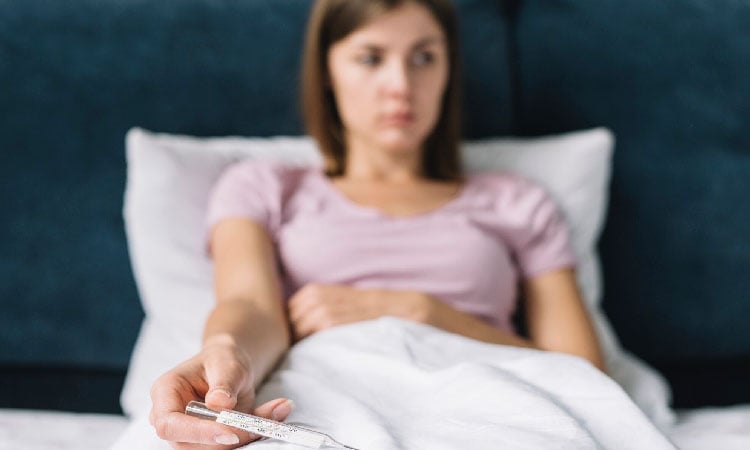The female reproductive system is incredibly complex and fascinating. The menstrual cycle is a complicated process that takes place in the female body. A variety of hormones and physiological changes control it. One important event in the menstrual cycle is ovulation, which is when a mature egg is released from the ovary. This typically happens in the middle of the cycle. After ovulation, a woman’s body goes through a series of changes that can result in various symptoms, regardless of whether she is actively trying to conceive or not. Sometimes, these symptoms can be misleading, causing confusion and raising concerns about pregnancy. This article delves into the symptoms after ovulation if not pregnant. It also provides insight into the underlying processes and their significance.
How Do I Know I Have Conceived After Ovulation?
Let us first take a closer look at the menstrual cycle and the significance of ovulation before discussing the symptoms that may arise after ovulation if conception has occurred.
There are three major stages of a woman’s menstrual cycle: the follicular phase, ovulation, and the luteal phase. Ovulation marks the transition from the follicular phase, during which an egg matures within a follicle, to the luteal phase, during which the body prepares for a possible pregnancy.
Ovulation does not always result in pregnancy. Women frequently experience a variety of symptoms in the days between ovulation and their period. These symptoms, in many cases, are identical to those that occur in the early stages of pregnancy.
This is because female hormones are involved in both ovulation and pregnancy, and the body gets ready for pregnancy following ovulation. For instance, elevated progesterone levels are common after ovulation and conception. This can result in breast tenderness, mood swings, fatigue, and changes in cervical mucus.
Related Reading: 9 Signs Of Ovulation To Know Your Most Fertile Time
Calculate Due Date With Conception Date
In addition, abdominal pain or discharge can occur during both ovulation and early pregnancy as a result of the physiological changes occurring in the reproductive system. Because of the similarities between the two, women attempting to conceive or keep track of their menstrual cycles may misunderstand their body’s signals.
Our panel gynaecologist Dr Ankita Patel Tayal says that if you are experiencing severe/stabbing cramps in your abdomen (especially if it is only on the right or the left side) along with nausea/vomiting, this may be a sign of an ovarian cyst or an ectopic pregnancy. If so, it is time to consider seeking emergency care.
Since a fertilized egg takes many days to travel down the fallopian tube and implant into the uterine lining, determining conception after ovulation is difficult. However, after ovulation, even though not all women notice or experience it, there are a few signs that suggest conception.
The following are some signs that conception has taken place after ovulation1:
- Cramps in the lower abdomen, similar to but milder than menstrual cramps
- Some women may experience implantation bleeding after a successful implantation, which is characterized by brown vaginal discharge that lasts for one to two days. Dr Ankita Patel Tayal, MD OBGYN, says that implantation bleeding usually tends to be lighter and shorter in duration than a period. Unlike menses, spotting associated with implantation will stay light and won’t develop into a full flow.
- Some women experience mild pelvic pain or a sense of fullness in the lower abdomen as the embryo implants into the uterus
- Breast tenderness and mild swelling are common during ovulation. It lasts a few days during ovulation and is persistent in pregnant women
- Heightened sense of smell and taste
- A slight increase in body temperature
- Increased urination
- Headache
- Fatigue
Related Reading: How To Make Implantation Successful Naturally – 5 Tips
How Many Days After Ovulation Do Pregnancy Symptoms Start?
Pregnancy symptoms can appear anytime after ovulation, with no hard-and-fast rule. This differs from woman to woman. In most cases, pregnancy symptoms won’t appear right after ovulation. Fertilized eggs normally take several days to make their way down the fallopian tube and implant in the uterine lining. The body starts making hCG once an embryo has been implanted.
The body recognizes pregnancy as a result of this hormone. After implantation, hCG levels begin to rise dramatically, doubling every 48 to 72 hours. After hCG levels have increased sufficiently, pregnancy symptoms usually set in.
Pregnancy symptoms usually appear between 7 and 14 days after conception, or around a week and a half to two weeks after ovulation. It’s possible that some women won’t know they’re pregnant until they’re many weeks along.
Breast tenderness, exhaustion, and changes in basal body temperature are all common early pregnancy symptoms, but they are not usually conclusive signs of pregnancy on their own. It is possible to feel pregnant before your period stops, but a missing period is the most reliable early indicator of pregnancy and the time to take a pregnancy test.
What Are The Symptoms After Ovulation If Not Pregnant?

After ovulation, many women eagerly search for signs and symptoms that could potentially indicate pregnancy. Although certain early pregnancy symptoms may appear soon after conception, it is important to understand that the absence of these signs does not necessarily indicate that you are not pregnant.
Similarly, it is important to note that experiencing early pregnancy symptoms does not necessarily indicate a confirmed pregnancy.
This is due to the fact that everything is hormonal, and the same hormones that cause PMS also cause the symptoms of early pregnancy. Progesterone is often identified as one of the main factors responsible for the challenges experienced during the two-week wait.
During the weeks following ovulation, your body naturally increases its production of progesterone, regardless of whether you are pregnant or not. Progesterone is a hormone that plays a significant role in causing various PMS symptoms, such as bloating, breast tenderness, and mood swings2.
So how can one tell she is not pregnant after ovulation? Following are some symptoms after ovulation if you are not pregnant:
- Drop in basal body temperature: One indication that there was no pregnancy following ovulation is a reduction in basal body temperature.If a woman’s basal body temperature (BBT) remains consistently high for at least 18 days after ovulation, it is a strong indication of pregnancy3. If, on the other hand, you were not successful in conceiving this month, your BBT will begin to fall again approximately 10 to 14 days after ovulation4
- A dramatic reduction in the cervical mucus: After ovulation, cervical mucus production will decrease. During the post-ovulation period of time, the mucus you produce may appear clouded, having a sticky or tacky consistency. In the event that the egg is successfully fertilized, you will notice an increase in the amount of vaginal discharge you experience as a result of the rising hormone levels in your body. If you are not pregnant, your cervical mucus will be dramatically reduced even as it dries up5
- Breast pain or tenderness: This may seem rather confusing, as it is also a symptom of pregnancy. However, due to fluctuations in hormone levels in the days following ovulation, the breast ducts and milk glands may swell, leading to breast pain and tenderness. This is especially evident as you approach your period. For a few days before menstruation, you may feel a dull, throbbing ache in your breasts, but the pain should ease up during or after your period
- Abdominal/Pelvic Cramping: Like breast pain, cramping is also a symptom that may occur when you are pregnant (called implantation cramping). If you are not pregnant, the cramping will tend to occur when you are closer to your period. Implantation cramping usually occurs around 6 days after ovulation, whereas premenstrual cramping occurs around 10-12 days after ovulation
- Cramps and discomfort: Additionally, implantation cramping is said to be quite mild. If you are not pregnant, your cramps will be more intense. Early pregnancy cramps can feel like prickling, tingling, or pulling and last a day or two6. On the other hand, if you are not pregnant, the cramps will be more intense and persist. In addition, if you are not pregnant, you may experience cramps on both sides, which may spread to your lower back and thighs7.
Related Reading: How To Cope With Painful Implantation Cramps?
Conclusion

In conclusion, determining whether or not you are pregnant after ovulation involves a combination of tracking your menstrual cycle, monitoring symptoms, and utilizing pregnancy tests. A reliable indicator is the timely arrival of your expected period, which strongly suggests that you are not pregnant. Negative results on home pregnancy tests can be reassuring, but it is important to wait until at least the day of your expected period or a few days after to obtain the most accurate results.



2 comments
It is very useful information about symptoms of Ovulation.
It is eye opening article. THANK YOU